Image credit Nikki Mael
The following article, It’s so Bad, All We Can do Now is Warn was originally published by Susan Thixton on . I strongly recommend signing up for her newsletter. She has an abundance of important information that pet owners. Susan is an activist who fights against the commercial pet food manufacturers.
Each day in the U.S. millions of pounds of adulterated pet foods are sold to unknowing consumers; an estimated $19 Million dollars worth every single day. Laws that govern pet food/animal feed have been ignored for so long, it’s so bad – so big – it is probably too late for anything other than a warning.
When people ask me what food I trust, I tell them about products that I have used for my own dogs. I have many articles about why biologically appropriate food is critical. Why a Raw Diet is Vital is one of many of my articles that explains why a raw species appropriate diet is so important to maintain optimal health. There are ways to make it less costly by making your own food, but it could be a big project.
The American Pet Products Association states in 2015 $23 billion worth of pet food was sold in the U.S. An estimated 30% of those sales were for pet food and treats that legally should not have been sold. Should not have been sold because federal and state laws define their ingredients as adulterated.
There are many laws governing pet food sold in the U.S. However these laws are of no benefit to consumers if they are not enforced. Consumer advocates Susan Thixton, Mollie Morrissette, Dr. Jean Hofve, Dr. Cathy Alinovi and Nina Wolf took a close look at state and federal law (governing pet food). We found lack of enforcement of pet food law to be so big, involving so many different pet foods and treats – that it is close to impossible to turn back now.
In the United States Code (law), Title 21, Chapter 9, Subchapter IV, Section 342 (The Federal Food, Drug and Cosmetic Act) – the law states that a food (food would include animal/pet food) is considered adulterated if it is sourced from a non-slaughtered animal (Section 342 a-5). This law is in place to protect consumers and their pets from the risk to consuming diseased or decomposing animal tissues.
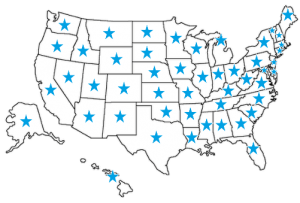
With research into State laws, we found that 14 States had the exact same law – clearly defining within state law a pet food as adulterated if it contains any part of a non-slaughtered animal. The following states are not only ignoring the above federal law, they are ignoring their own state law too: Arkansas, Connecticut, Florida, Idaho, Indiana, Kansas, Kentucky, Michigan, Minnesota, Mississippi, Missouri, Montana, New Mexico, and North Dakota.

How do we know that states are ignoring federal and state law? We know – because of the legal definition of seven commonly used ingredients in pet food.
Pet food ingredient definitions are quite specific. The concern with federal and state law enforcement is the legal requirement – within the pet food ingredient definition – to whether it is required or not required to be sourced from a slaughtered animal. Pet food ingredients sourced from a slaughtered animal would be legal (per federal and state law). Pet food ingredients sourced from a non-slaughtered animal would not be legal (per federal and state law).
Examples of non-slaughtered animals we know with certainty are allowed to be included in the pet food ingredients listed below – are livestock animals that have died in the field and spent laying hens. At the AAFCO meeting in August 2015, all consumer advocates in attendance (Susan Thixton, Mollie Morrissette, Dr. Jean Hofve, Nina Wolf, Dr. Cathy Alinovi, Dr. Karen Becker, Dr. Judy Morgan, BC Henchen and Rodney Habib) were witness to the discussion of non-slaughtered spent laying hens ground whole – feathers, feet, feces and all – becoming the pet food ingredients chicken/poultry by-products and chicken/poultry by-product meal.
The legal definition of another ingredient – meat and bone meal – allows the inclusion of “hair, hoof, horn, hide trimmings, manure…” Manure – on the non-slaughtered animal body and in the animal – becomes part of the pet food ingredient. Non-slaughtered animals are also most likely to contain high levels of pathogenic bacteria such as Salmonella and E. coli. Though the bacteria are killed in the cooking process of the pet food, there remain potentially dangerous levels of endotoxins that can sicken or kill pets. The USDA states: “The cooking step of the rendering process kills most bacteria, but does not eliminate endotoxins produced by some bacteria during the decay of carcass tissue. These toxins can cause disease, and pet food manufacturers do not test their products for endotoxins.” (To read more about the risk of endotoxins, Click Here)
Below is a chart of some (not all) commonly used pet food meat/animal protein ingredients. Per their legal definition, they are listed in a column that requires them to be sourced from a slaughtered animal (black), or listed in a column that does not require them to be sourced from a slaughtered animal (red). Red/non-slaughtered animal material ingredients are considered adulterated per federal law and state law in 14 states.
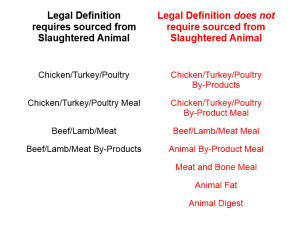
We are not stating that every pet food that uses one of the above ingredients is sourcing from an illegal non-slaughtered animal. That is part of the problem – pet food consumers are not told who is sourcing from adulterated/illegal non-slaughtered animals and who isn’t. All we know with certainty is what the legal requirement of the ingredient is – if the ingredient definition requires the animal source to be a slaughtered animal or if the ingredient definition does not require the animal source to be slaughtered.
Example: Florida – defines an adulterated pet food as (in part):

BUT…in every grocery store, every big box retail store, every big box pet food store in Florida are pet foods that contain ingredients that can be sourced from a non-slaughtered animal. For example: Beneful Dog Food.
Beneful Dog Food (original, chicken recipe) contains three ingredients whose legal definition allows them to be sourced from non-slaughtered animals; chicken by-product meal, animal fat and animal digest. Instead of enforcing federal law and enforcing state law, Florida is allowing this pet food and perhaps thousands of other pet products to contain non-slaughtered animal ingredients – with no concern to the consumer purchasing the pet food or the pet consuming it.
One more example: Missouri defines an adulterated pet food as (in part):
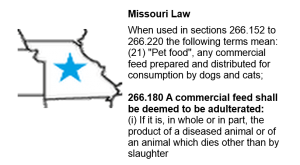
But…in every grocery store, every big box retail store, every big box pet food store in Missouri are pet foods that contain ingredients that can be sourced from a non-slaughtered animal. For example: Meow Mix Cat Food.
Meow Mix Cat Food contains four ingredients whose legal definition allows them to be sourced from non-slaughtered animals; chicken by-product meal, animal fat, animal digest and turkey by-product meal. Instead of enforcing federal law and enforcing state law, Missouri is allowing this pet food and perhaps thousands of other pet products to contain adulterated ingredients – with no concern to the consumer purchasing the pet food or the pet consuming it.
How can this be? How can so many commonly used pet food/treat ingredients included in thousands of pet products be considered adulterated/illegal per federal and state law? We tried asking, but our questions went unanswered. Before I get to that…there’s more law being ignored.
In the same United States Code (law), Section 343 defines a food whose labeling is false or misleading in ANY manner to be misbranded. A misbranded pet food would be illegal. Again, this federal law is in place to protect consumers and their pets.
The following image shows in red the states (all of them) that do not enforce the above federal law with pet food.
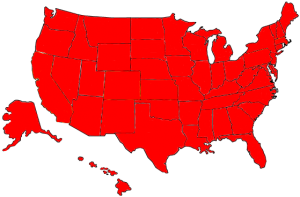
We found 42 states had very similar misleading labeling laws as the federal law. Most states had laws that declared a pet food adulterated if an image on the label reflects a quality different from what is in the pet food. Example: if grilled chicken was shown on the label, and the pet food is not made from grilled chicken – that pet food should be declared adulterated because its label reflects a quality different than the pet food. In the following graphic, red indicates state labeling laws specific to pet food ignored.
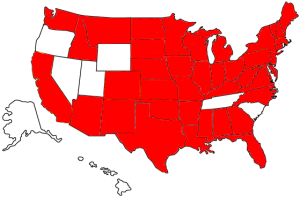
Example: Georgia law states:

BUT…in every grocery store, every big box retail store, every big box pet food store in Georgia is (as example) varieties from Pedigree Dog Food, Hill’s Science Diet Crafted Pet Food, and FreshPet Pet Food. Varieties of these pet foods show grilled meat or roasted meat on the label, but there is no grilled or roasted meat in the pet food. The ‘quality’ of the pet food falls below what is ‘represented on the label’. Instead of enforcing federal and state labeling law, Georgia is allowing these pet foods and hundreds of others to display misleading images on the label – with no concern to the consumer purchasing the pet food or the pet consuming it.
How can this be happening? How can so many states ignore their own state law allowing thousands of pet food and treat products to be adulterated? We asked two states, but they did not respond.
An email was sent to Florida Department of Agriculture on February 15, 2016 asking why state law is not being enforced with pet food. On Tuesday, February 16, 2016 a follow-up phone call was made to FL Department of Agriculture – message left. To date, no response has been received.
An email was sent to Missouri Department of Agriculture on February 17, 2016 asking why state law is not being enforced with pet food. A Missouri Department of Agriculture representative is the co-chair of AAFCO’s pet food committee, we thought certainly this person could provide us with information…an explanation. To date, no response has been received.
Assumption: they cannot respond because they would have to admit their own state laws are not being enforced. They can’t tell us why they can’t tell us anything – it would be very incriminating if they did.
The FDA website tells us that most states have adopted the federal laws we have discussed above. Click Here to view. This FDA webpage also tells us that most states have adopted the full federal law as state law, but not all. Without the aid of a legal genius, it’s challenging to determine which states follow all federal law. What we are certain of, the red states in the graphic below are ignoring their own state pet food labeling laws – and the starred states are ignoring their own state law allowing adulterated ingredient pet foods to be sold to unknowing consumers.

Question. Why do all of you and I have to abide by law, and federal/state agencies do not?
What can consumers do?
Specific to the state and federal law that requires all pet food ingredients to be sourced from slaughtered animals, because state and federal authorities have ignored enforcement for so long, the “problem” has grown to an estimated 30% of all pet foods and treats now contain an adulterated (non-slaughtered animal) ingredient. It is impossible at this point – to swiftly remove or recall all of the adulterated pet foods and treats. The problem is out of control. Though it is what all pet food consumers (and their pets) deserve, this cannot change in an instant.
We must consider that many, many families can only afford this type of pet food. We must consider too that animal shelters can only afford the cheapest of pet foods – which are most likely to contain one of the non-slaughtered animal/illegal ingredients. It is not our goal to financially damage a family, a shelter, the pet food industry or the pet food ingredient supplier industry just because regulatory authorities have not enforced the law.
The only thing to do at this point – is to require pet foods that include an ingredient allowed to contain a non-slaughtered animal to place a warning on the label. And this warning needs to be implemented immediately. This is – at the very least – what pet food regulatory authorities can do to protect unknowing consumers.

We ask consumers to report the violations of law to state authorities – our representatives in Congress and our State Attorney General. We can make them very aware of these serious laws being ignored and ask them to…
1. We ask authorities to require all pet foods/treats with ingredients whose definition does not require it to be sourced from a slaughtered animal (a violation of federal and state law) to include a warning on the label. Example warning label: ‘Warning. This pet food could contain ingredients that are in violation of federal and state law. Handle and store with care.’ The consumer warning should be required to be implemented immediately and placed in a highly visible area on the pet food label.
2. We ask authorities to enforce federal and state labeling laws, making certain that a pet food displaying grilled meat on the label actually contains grilled meat.We have provided pet food consumers with the laws of each state for these issues. And we have provided an example letter for your representatives in Congress and your State Attorney General specific to the laws in each state.
Please click on the link below to your state – send your emails. Please share this post asking every single pet food owner to do the same. A warning notice on these pet foods is the VERY LEAST thing that authorities should do for pet food consumers. But they won’t do it on their own – we must ask.
Sources:
| Thixton, Susan. “It’s So Bad, All We Can do Now is Warn.” Truth about Pet Food, Susan Thixton, 10 Apr. 2016, truthaboutpetfood.com/its-so-bad-all-we-can-do-now-is-warn/. |








